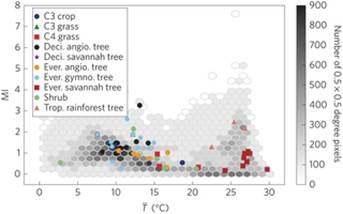植物的水交换也有“策略”
来源:《Nature Climate Change》
作者:Yan-Shih Lin
时间:2015-04-17

据美国物理学家组织网近日报道,一项来自澳大利亚研究人员的新研究表明,植物的水交换是“智慧”的,不同的植物种类有不同的水交换策略,这取决于它们获得水所需的“成本”。该研究成果发表在近期的《自然气候变化》上。
“我们的研究是观察一种植物获得更多克数的碳要用多少额外的水。”该研究主要作者麦克里大学的林博士说,“我们预测植物个体应该是保持交换率不变的,但交换率取决于植物类型和生长地。”
来自不同生态系统的数据对比结果显示,多数研究者的预测已表明植物的用水策略与其所处的环境相适宜。而最令人震惊的却是,常绿树木是最挥霍无度水的植物,尽管其生活在炎热和干旱的环境中。研究人员还预测,生长在寒冷或干燥环境中的植物应该比那些适应了炎热或潮湿环境的植物更“吝啬”水。
研究人员表示,他们联合全球各地的研究人员收集了各种生态系统的数据。从北极苔原、亚马孙雨林到澳大利亚人烟稀少的腹地都包括在内。
林博士说:“这项研究很重要,因为通过该研究可以深入了解植物是如何适应环境的。植物在地球系统中发挥着重要作用,体现在储存碳、移动土壤中的水及给地球表面降温。这些结果为我们提供了预测其作用的新的重要信息,特别是在不同的气候条件下。”(来源:科技日报 李玥)
Optimal stomatal behaviour around the world
Abstract Stomatal conductance (gs) is a key land-surface attribute as it links transpiration, the dominant component of global land evapotranspiration, and photosynthesis, the driving force of the global carbon cycle. Despite the pivotal role of gs in predictions of global water and carbon cycle changes, a global-scale database and an associated globally applicable model of gs that allow predictions of stomatal behaviour are lacking. Here, we present a database of globally distributed gs obtained in the field for a wide range of plant functional types (PFTs) and biomes. We find that stomatal behaviour differs among PFTs according to their marginal carbon cost of water use, as predicted by the theory underpinning the optimal stomatal model and the leaf and wood economics spectrum. We also demonstrate a global relationship with climate. These findings provide a robust theoretical framework for understanding and predicting the behaviour of gs across biomes and across PFTs that can be applied to regional, continental and global-scale modelling of ecosystem productivity, energy balance and ecohydrological processes in a future changing climate.
原文链接:http://www.nature.com/nclimate/journal/vaop/ncurrent/full/nclimate2550.html#access




